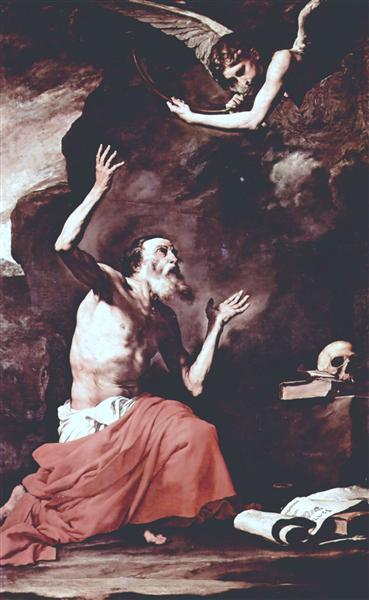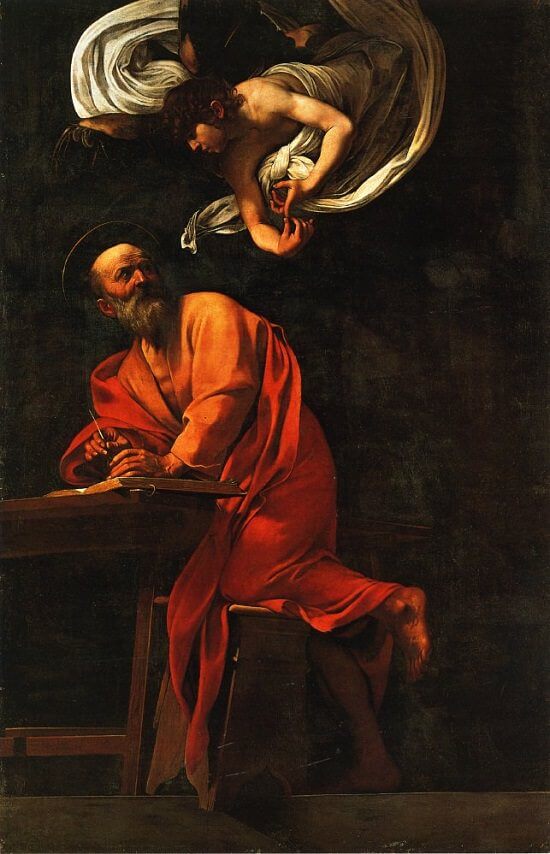The Baroque style of art was predominant from the early 17th century up to the 1750s; that compared between regions and reintroduced religion after being prohibited for their glorification of the ethereal and ideal. In 1602, the painting The Calling of St. Mathew was commissioned in the Contarelli church, San Luigi dei Frances, Rome, by depicting a theme of martyrdom and death with an image representing Saint Mathew interacting with an angel above.
Similarly, St Jerome and the Angel of Judgment utilizes a thematic subject of martyrdom and death commissioned at the church of Santissima Trinita Delle Monache, Spain, in 1626, depicting saint Jerome kneeling and looking up at an angel. An analogy of the second version of The Calling of St Matthew by Caravaggio of Italy and St. Jerome and the Angel of Judgment by Ribera Jusepe of Spain indicates collating differences and similarities.
Baroque Stylistic Similarities and Differences
First, both arts exhibit the same qualities of drama, grandeur, movement, and emotional sensitivity, using human and allegorical figures, which is standard in Baroque art. However, the Spanish baroque has more expression of emotional sensitivity, dramatic effect, and classism stylistic characteristics compared to the Italian baroque. Depicted in Figure 1 below of St. Jerome and the Angel of Judgment painting, Jerome is kneeling with his hands lifted to the angel, and his face depicts terror to emphasize drama and emotional sensitivity (De Ribera 1). Contrastingly, in Figure 2 below of The Calling of St Mathew of French, Matthew is seemingly taking points from the angel and writing them (Caravaggio, 2). Moreover, the Spanish baroque by Ribera has neo-classical features of nudity represented in Jerome’s robe covered from the waist down with a red cloth different from Matthew’s robe that is evocative of an ancient philosopher.


Role of the Cultural Context on Similarities
Both paintings’ cultural context and theme are religious to elicit resemblance. Both are inspired by religion, commissioned in church, involve a mythical creature as an angel, and share the theme of martyrdom and death. Additionally, The Calling of St. Mathew and St Jerome and the Angel of Judgment derive their subject from the bible and utilize biblical figures, Matthew and Jerome, respectively. Therefore, both artworks have a religious and cultural context to include mythical creatures in the form of an angel, biblical subjects, and figures.
Subject Matter of the Paintings in Relation to the Cultural Context
While the Subject matter in The Calling of St Mathew is God’s inspiration for Christian fellowship, the subject of St Jerome and the Angel of Judgment is symbolic of human mortality during judgment day. As demonstrated in Figure 1, it is inspired by a biblical story when St Jerome had a vision of God’s angel blowing the last trumpet to herald (Art History 12). The skull beside Jerome and the lion standing behind him signifies death and a saint, respectively. In The Calling of St Matthew, an angel dictates the Gospel to Matthew as he is recording, demonstrating the theme of divine inspiration in the scriptures. Mathew’s role in the art is implied by his name, constructed from the terms “manus” (hand) and “theos” (God) to indicate the hand of God (Caravaggio 2). The religious and cultural context informs both subjects of the artworks.
Conclusion
Comparative analysis of The Calling of St Matthew of Italy baroque and St Jerome and the Angel of Judgment utilizing Spanish Baroque indicates characteristics of Baroque art, similarities, and differences. Although both arts have similar thematic subjects, cultures, and features common to baroque art, Spanish baroque is more expressive of emotional sensitivity and dramatic effect than Italian baroque. Art during the baroque period had typical characteristics of drama, tension, and emotional exuberance that subtly differed between regions.
Works Cited
Art History. “Southern Baroque: Italy and Spain.” Art History Teaching Resources. 2018. Web.
Caravaggio, Michelangelo. The Calling of Saint Matthew – by Caravaggio, 1602. Web.
De Ribera, Jusepe. “St. Jerome and the Angel of Judgement, by De Ribera (1626).” Death and Gender in Early Modernity. Web.